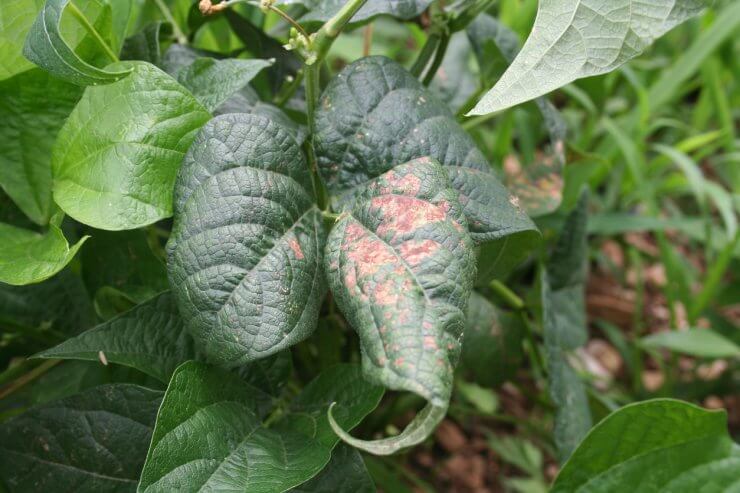
Green bean plant damaged by disease
Like all food crops, green beans are susceptible to various fungal diseases. Your greatest weapons against these are best planting practices, which help prevent disease in the first place.
This is especially important, as there are no fungicides approved for home use for many diseases.
These best practices are aimed at producing strong, healthy green bean plants that can withstand disease, and at avoiding situations that contribute to the development of disease. They involve keeping plants clean, dry, and undamaged.
Watering: Water your green beans deeply about once a week (check the soil for dryness). Do not over-water; soggy soil invites disease.
Mulch: Mulch can help with water retention—but be vigilant and check for insect or fungal activity.
Other best practices include:
- Buy healthy, disease-free plants from reputable sources
- Select varieties that are disease-resistant
- Plant your green beans in full sun
- Plant in sites with good drainage; if planting in open ground, choose a higher spot for better drainage
- Harvest frequently and remove infected plants and fruit
Common green bean diseases
Here are some of the usual culprits that might infest your green beans. Remember, it’s important to remove diseased fruit, flowers, and leaves to prevent the spread of disease once it’s found its way onto your plants.
Anthracnose
Cause: Fungus
Symptoms:
- leaves turn yellow at the tips, eventually turning brown all around
- browned, dying leaves
- dark, sunken lesions on fruit and/or stems
How it Spreads:
- spores spread by rain, splashing water
- wind
Treatment:
- remove all infected parts
- apply liquid copper fungicide to reduce recurrence
Prevention:
- space plants
- provide support for climbing beans to allow good air circulation and access to sunlight
- provide proper water and fertilizer
Powdery Mildew
Cause: Moist conditions
Symptoms:
- ashy white powder on the top sides of foliage
How it Spreads:
- warm, moist conditions encourage spores that spread rapidly
Treatment:
- apply horticultural oils such as neem or jojoba
- introduce beneficial non-toxic organisms such as Bacillus subtilus
Prevention:
White Mold/Sclerotinia
Cause: Fungal infection
Symptoms:
- stem appears to have a water-soaked section
- stems may have brown lesions from which cotton-like growth emerges
- leaves wilt, yellow, and die
- pods may rot
How it Spreads:
- fungus releases spores that carry on the wind to infect plants, usually during cool weather
Treatment:
- destroy affected plants immediately
- remove any infected soil and replace with clean soil
- use a barrier, such as mulch or plastic to keep infected soil away from plants
Prevention:
- avoid overhead watering
- water early in the morning
- provide support for climbing beans to improve air circulation and don’t plant bush beans too close together
- control weeds
- spray your plants with an approved fungicide to help prevent infection; spray the plants right before they bud, then spray again a week later
- remove affected plants after the growing season to prevent spores from overwintering
Which diseases have you had to handle on your green bean plants? Please tell us how you prevent and handle diseases. If you spot other symptoms on your green beans that are not mentioned here, contact your local extension center or garden center for a consult—and please let us know what you found.


 Previous
Previous


These growing guides are fantastic! I fear I’m just beginning the fight right now with anthracnose. Thanks for the thorough info. Tm.